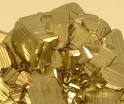Pyrite is a very common mineral that sometimes goes under quite a few other names, most notably Marcasite and Fools Gold. Pyrite is a Greek word that means fire and Pyrite definitely fits into this category. Pyrite is a beautiful mineral and extremely interesting. Its main quality is that it resembles gold.
Pyrite is usually yellow, golden or very brassy in hue. While it has a decent hardness, scoring a 6.5 to 7 on the Moh’s scale, it is very brittle and will break away in chunks when fitted for jewelry. While it does not make a good component for jewelry on its own, it does sometimes find itself in lots of jewelry usually under the term Marcasite when mixed with silver and it is also found as inclusions in Lapis Lazuli.


Pyrite is made from iron and sulfur, its chemical properties are written as FeS2. It is extremely common and found throughout the world. It does have crystal properties that form wonderful block crystals and while these crystals are not the type for ornamental jewelry, Pyrite on its own is a favorite of gemologists and mineral collectors.
Besides being a part of certain ornamental jewelry pieces, Pyrite has had other uses, mainly for the production of sulfur products that are used either when manufacturing paper or to create sulfur gas, which is mainly used for industrial purposes. Pyrite also creates sparks when hit up against steel and was used in early rifles. Whether you are a gem collector or like the sparkle and fire that Pyrite brings to silver or other gemstones, Pyrite is extremely interesting and very attractive.
One of the most attractive minerals in the world is Pyrite; unfortunately it is a very common stone and is not that valuable. Pyrite is sometimes called Fool’s Gold and is incorrectly termed Marcasite when mixed with silver. Pyrite has been known to man since ancient times and gets its name from the Greek word Pyr, which means fire.
While Pyrite is an extremely common mineral, it is very attractive. While Pyrite is decently hard, with a score of 6.5 to 7 on Moh’s hardness scale, it can not be used for most types of ornamental jewelry, because it tends to be extremely brittle and will break apart very easily.
However, since Pyrite is not the main mineral used in many ornamental pieces, it can be used sparingly. For instance, many people that are knowledgeable about silver will know Pyrite as the term Marcasite. Marcasite is incorrectly labeled as the mineral, although it is closely associated with Pyrite, only Pyrite is used with silver. Pyrite is also found in small particles in Lapis Lazuli, a wonderful blue stone that sometimes includes specs of Pyrite that increases the value. A fun fact to know is that Pyrite sometimes termed Fool’s Gold is usually found in real gold, because it is also a popular gold ore.
Besides ornamental jewelry, Pyrite has certain other uses including industrial uses such as in the manufacturing of paper and the creation of sulfur gas. Pyrite is an extremely popular mineral and can be found almost everywhere in the world.